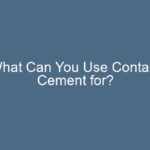Home Improvement

When it comes to adhesives, there are many options to choose from. But for some surfaces, only contact cement will do the job effectively. Contact cement, also known as contact adhesive, is a neoprene rubber adhesive that creates a fast, flexible, and permanent bond. It’s best suited for nonporous materials that other adhesives can’t hold together.
This type of adhesive is particularly useful for plastics, veneers, rubber, glass, metal, and leather. It’s commonly used for large surfaces such as kitchen and bathroom countertops, where laminates are hard, thin plastic surfaces glued together with contact cement. Unlike other glues that need to dry after assembly, contact cement is already dry on contact. Once the solvent evaporates, the cement forms a flexible bond with no residual moisture. This means there’s no need for clamping, making it a great option for gluing floor tiles.
It’s important to note that contact cement is different from other adhesives in that it needs to air-dry for 15 to 20 minutes before assembly. The cement must be applied to both parts so that the glue bonds to itself. Although it’s not sticky, the solvent is added for easier application and must evaporate completely before joining the two parts. It’s tricky to apply because the adhesive only needs a momentary contact to form a permanent bond.
It’s also worth mentioning that solvent-based contact cement releases volatile organic compounds, which are regulated by the U.S. Environmental Protection Agency because they are toxic and flammable. It’s essential to ensure that your work area is well-ventilated. Alternatively, newer water-based contact cements are nontoxic and environmentally friendly.
Contact Cement FAQs
What is contact cement?
Contact cement is a neoprene rubber adhesive that creates a permanent, quick, and flexible bond. It’s commonly used for nonporous materials.
Is contact cement the same as rubber cement?
No. Rubber cement provides a temporary hold, while contact cement provides a permanent one.
Are there materials that contact cement does not stick to?
Water-based contact cement doesn’t adhere well to metal or glass, while solvent-based contact cement does. Neither type of cement sticks well to masonry.
What are the uses of contact cement?
Contact cement is typically used to glue rubber, tile, Formica, metal, and plastics together.
Originally published on July 20, 2011.
FAQ
1. What is contact cement?
Contact cement, also known as contact adhesive, is a type of adhesive that is applied to both surfaces that are to be bonded. The adhesive dries quickly and forms a strong, permanent bond between the two surfaces. Contact cement is widely used in the construction industry and for DIY projects.
2. What materials can be bonded with contact cement?
Contact cement can bond a wide variety of materials, including wood, metal, plastic, leather, rubber, cork, and fabric. It is ideal for bonding materials that are difficult to bond with other types of adhesives.
3. What are the advantages of using contact cement?
One of the main advantages of contact cement is its ability to create a strong, permanent bond between two surfaces. It is also waterproof and heat resistant, making it ideal for use in outdoor applications. Additionally, contact cement is easy to apply and dries quickly.
4. What are some common uses for contact cement?
Contact cement is commonly used in the construction industry for bonding materials such as flooring, countertops, and wall coverings. It is also used in the automotive industry for bonding upholstery and trim. In the DIY world, contact cement is often used for projects such as reupholstering furniture or creating custom costumes.
5. Can contact cement be used on vertical surfaces?
Yes, contact cement can be used on vertical surfaces. However, it is important to apply the adhesive in thin coats and allow it to dry completely before bonding the two surfaces together. It may also be necessary to use clamps or weights to hold the surfaces in place while the adhesive dries.
6. Is contact cement toxic?
Contact cement is a flammable, solvent-based adhesive that can be toxic if inhaled or ingested. It is important to use contact cement in a well-ventilated area and to follow all safety precautions on the product label.
7. Can contact cement be removed?
Once contact cement has dried and formed a bond between two surfaces, it is difficult to remove. However, it may be possible to loosen the bond by applying heat or using a solvent such as acetone. It is important to follow all safety precautions when attempting to remove contact cement.
8. How should contact cement be stored?
Contact cement should be stored in a cool, dry place away from sources of heat or flame. The adhesive should be kept tightly sealed to prevent evaporation. It is also important to keep contact cement out of the reach of children and pets.

Brody is a skilled craftsman and gardening expert. From renovating living spaces to cultivating lush gardens, Brody’s knowledge and passion shine through, inspiring readers to embark on their own home improvement and gardening journeys with confidence.






Leave a Reply